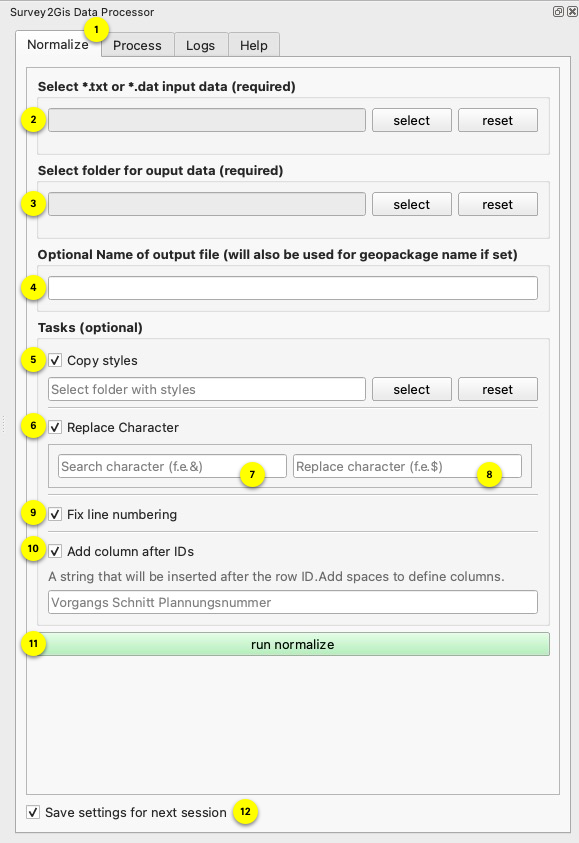Tab Normalize
The Normalize tab combines individual measurement data into a single file. The combined file can be cleaned up using various tasks. Furthermore, possible *.qml (QGIS) styles can be copied to a defined output folder.

-
Open Normalize
Click to open the Normalize tool. -
Select input files
Choose your input files from your hard drive. Supported file extensions are*.datand*.txt. - Select the output folder
Select the folder where the combined data will be saved.Use the same output folder in the Process tab for all generated
*.shpfiles. - Name your output file
Give your output file a meaningful name.If you specify a name here, it will also be used in the Process tab for naming the generated GeoPackage.
-
Add optional QML files
If you have a folder containing*.qmlfiles (optionally with an svg subfolder), you can select it here. The tool will copy these files to your output folder. If a*.qmlfile matches the name of a generated GIS layer, it will automatically be applied to the layer when loaded in QGIS. -
Replace special characters
The replacement rules work as follows:- When the replace field (8) is empty:
- Example: search=”&”, replace=”” → “&” is deleted from the file
- When no spaces in both fields (7)(8):
- Example: search=”&”, replace=”$” → “&” is replaced with “$”
- The strings are treated and replaced as a whole
- When spaces are present (character by character replacement):
- Example with matching length: search=”d o g s”, replace=”c a t s” →
- “d” is replaced with “c”
- “o” is replaced with “a”
- “g” is replaced with “t”
- ”s” is replaced with “s”
- Example:
Input: "The dogs run" Output: "The cats run" - Example with different length: search=”d o g s”, replace=”c a t” →
- “d” is replaced with “c”
- “o” is replaced with “a”
- “g” is replaced with “t”
- ”s” remains unchanged (no replacement character available)
- Example:
Input: "The dogs run" Output: "The cats run"
- Example with matching length: search=”d o g s”, replace=”c a t s” →
These rules allow for deletion of characters, complete replacements, and character-by-character replacements with multiple characters.
- When the replace field (8) is empty:
-
Renumber input lines
This option rewrites all lines to start from 1 and increment to N. - Define additional fields
If your parser defines fields that are not present in your input data but are required, specify them here. Each space represents a column in the merged output and will be inserted directly after the line number. Don’t forget a space after the last word, otherwise the characters are directly placed before the next word.Original line in input file: 1 1_1 x… 020_21 1_ with space at the end will become: 1 2020_21 1_ 1_1 x… 2020_21 1_ without space at the end will become: 1 2020_21 1_1_1 x… -
Start the process
A button click starts the process. Errors will be written to Tab Logs. - Save settings
When checked your configuration of tab Normalize will be saved.